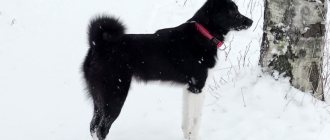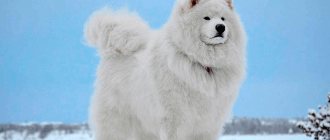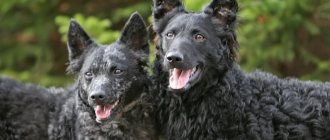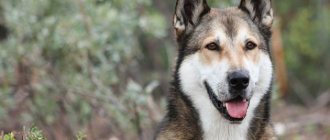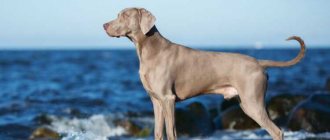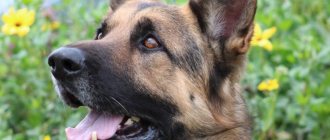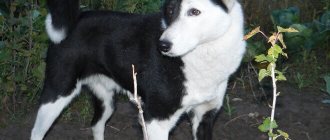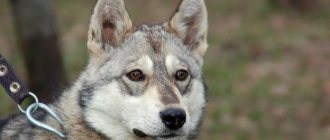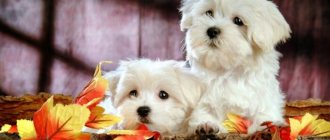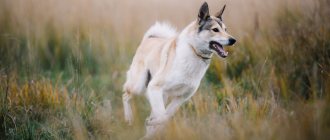/ Dogs / Dog breeds / Description of the Emthund breed
0
1564
Article rating
Laikas in general are considered one of the most ancient representatives of the domesticated dog breed. Northern peoples used them for hunting and shepherding back in the dark ages. The Emthund, or Swedish Husky, fits this description perfectly. It is considered one of the most ancient dog breeds on earth. It is difficult to classify Swedish and Scandinavian breeds in general, but Swedish Laikas have already been recognized by the FCI, which says a lot.
Emthund (Swedish Husky)
Breed standard
The breed was recognized as an independent breed in Sweden in 1946, but its official registration in the international register took place only in 1998. The breed standard was first compiled and published in 1953.
- Height: male: 60 – 63 cm, female: 58 – 61 cm.
- Weight: about 30 kg .
- Life expectancy: 12 – 14 years .
History of the breed
The Swedish White Elkhound, also known as the Great Swedish Elkhound, or the Bear Dog, is the oldest breed of canine when it comes to northern hunting dogs. Representatives of this breed have long and firmly established themselves in Scandinavia - researchers say that the age of the breed is at least two to three millennia.
Another interesting fact: among the ancestors of Elkhunds there are wolves - experts say this, and this is confirmed by DNA analysis.
Initially, white puppies of hunting huskies were considered defective - there was no demand for them, and only in 1942 there were lovers of snow-white beauties. A legend was even invented that moose, seeing white dogs, freeze, as if struck by thunder and lightning, becoming incredibly easy prey for hunters. Whether the reason for this is a legend or other factors, but at a certain point the demand for white huskies began to grow rapidly.
In 1986, a club for white Elkhound lovers was organized in Sweden. This was a separate organization that was not part of either the Swedish Kennel Club or the Swedish Elkhound Club. Since that time, breed selection has moved to a new level - white Elkhounds have become popular not only in their homeland, Sweden, but also in Finland and Norway.
In 1993, a standard was adopted and the breed was officially recognized by the Swedish Kennel Club. The FCI has not yet recognized the breed, but breeders do not lose hope and are actively working in this direction.
Brief history of origin
The Norwegian Husky is one of the oldest breeds in Scandinavia. In Norway, the animals have been used for centuries to hunt moose - the official name "elkhund" is translated from Norwegian as "elk dog". However, who her ancestors were remains a mystery.
In 1877, huskies took part for the first time in an exhibition organized by the Norwegian Hunters' Association. Two years later they were recognized by the Norwegian and Swedish Kennel Clubs.
Initially, all dogs were exclusively gray. Only at the beginning of the 20th century, Norwegian breeders developed a new variety - the black husky, which differs only in color and size. The FCI recognized both species in 1955.
Character of the Yamthund breed
The dog helps to hunt elk.
Yamthunds have all the qualities necessary for hunters - courage, perseverance, high physical and psychological stability. For such dogs, serious upbringing is important, otherwise endurance and perseverance will result in excessive energy and stubbornness for the owner.
Owning such a pet is definitely worth it for experienced people who know exactly for what purpose Yamthunds are owned. If you show persistence and patience, you can raise a wonderful dog, a strong protector who will be devoted with all his heart.
Appearance
The Swedish Husky has a respectable size and is harmoniously and proportionally built. The wedge-shaped head is quite large, with an elongated muzzle. The bridge of the nose is straight, the lobe is black. Dark brown eyes are almond shaped. The medium-sized ears are set high, erect, and triangular.
The jaws are moderately developed and have a scissor bite. The lips are narrow and fit tightly to the muzzle. The neck is powerful, without dewlap, with pronounced withers. The chest is strong and moderately wide. The back line is straight, with a slight slope towards the croup. The stomach is taut. The forelimbs are straight, even, moderately muscular.
The paws are collected and quite large. The hind limbs are more powerful, with developed hock joints. The tail is set high, has medium length, and is curled over the back.
Coat
The coat is quite hard to the touch, medium in length. There is a thick undercoat. In the abdomen, back of the thighs and on the tail, the cover is longer and forms feathers.
Color
The Emthund has a “wolf” color - the main color is gray with smooth transitions to lighter or darker shades. The hairs of the fur at the ends are much darker than at the base. The neck and muzzle are often tan or light grey.
Character
The Swedish Husky has a calm and balanced character. She is extremely loyal to her owner. The Laika behaves friendly with children, but it is not recommended to leave it as a nanny with children. Shows caution towards unfamiliar people, but not aggression.
Like many hunting dog breeds, the Emthound can exhibit independence or even stubbornness in its behavior. To avoid this, you need to constantly train your dog and practice obedience skills. When meeting other dogs, the pet often behaves unfriendly, but it will not be the first to attack.
Pros and cons of the breed
Swiss huskies are unpretentious animals. But it is not recommended to keep them in apartments - there is not enough space there to lead an active lifestyle. The advantages of the breed include the following:
- lack of aggression towards humans;
- energy;
- activity;
- high intelligence;
- endurance to work;
- loyalty to the owner;
- developed hunting instinct;
- no need to supplement with vitamins and minerals to improve immunity.
- proud disposition;
- difficulty in training;
- a tendency to certain genetic diseases.
Representatives of the breed are distinguished by a cold temperament - sometimes they refuse to make contact.
Peculiarities
The dog is distinguished by its courage, calm and affectionate disposition, loyalty, and energy. At the same time, he is a very stubborn and wayward dog. He is prone to dominance, but is in dire need of attention and love from all family members. Shows wariness towards strangers, but without aggression. If a dog grows up surrounded by cats and dogs, he has a neutral attitude towards them, but a hostile attitude towards strangers. The breed is characterized by excellent watchdog and security qualities, which are realized without additional training.
Breed standard
| FCI Standard No. 42 Standard publication date: 03/25/2003. Country of origin: Sweden. | FCI Classification Group 5. Spitz and primitive types of dogs. Section 2. Scandinavian hunting dogs. With operational tests (Sweden, Finland, Finland). |
Feeding rules
Swedish White Elkhounds are robust dogs that need to be kept in good physical shape. Accordingly, all this should be reflected in nutrition.
If you decide to feed your pet dry industrial food, choose a brand of at least premium class - such food contains all the necessary micro- and macroelements and vitamins.
When feeding natural food, you need to ensure that the diet includes lean meat, offal, dairy products, vegetables and cereals. If necessary, you can also offer your pet a vitamin complex selected by your veterinarian.
Description of the breed
The Swedish White Elkhound is a strong, beautiful, rectangular dog of medium size. An elongated muzzle, a black (or pink, brown) nose, erect, widely spaced ears, muscular paws, a fluffy tail curled into a donut.
The main advantage of the dog is its coat: thick, dense, with abundant undercoat, which protects against the cold in the most severe frosts. White color is the calling card of the breed; standards allow a slight yellowish tint.
Content
The Jämtland Laika is not suited to living in a cramped city apartment. She needs to have at her disposal a spacious enclosure or a fenced yard of a country house. The dog can comfortably tolerate cold climates thanks to its warm undercoat.
Of course, her main vocation is hunting, and a long pursuit of game will allow her to direct her energy in the right direction. However, not all Laika owners are hunters. Therefore, to compensate for the lack of hunting, the owner of the emthund must spend a long time every day walking through the forested area, engaging in physical exercise and active games with the pet.
Care and maintenance
The Swedish Laika is not suitable for keeping in a city apartment.
Its size and thirst for movement require space and active action.
She is also prone to independent walks and exploration, so personal space and freedom are important to her. A private house with a spacious enclosure is ideal for keeping.
Long walks through the forest and hunting trips will help your husky stay in shape.
Thick, dense coat does not need to be washed or brushed; you just need to help the dog during the shedding period and prevent the coat from matting.
The luxurious fur coat and northern origin of the dog make its presence in southern countries complex and difficult. But the Russian realities of frosty winters and cool summers are quite suitable for the breed.
When keeping it, it is important to take into account the diet: an adult is fed 2 times a day, while a puppy is fed 5 times.
For huskies, natural products are preferable to dry food. This will help avoid problems with the digestive system.
Dairy products should be avoided - they are not digested by adults.
The diet should be balanced, with a sufficient amount of protein: meat, offal, sea fish. The serving size is selected individually and depends on the dog’s physical activity.
You should not overfeed - the Swedish husky quickly gains weight.
The Jämtland or Swedish Laika is characterized by a high degree of devotion to its owner and a patient, loving attitude towards other family members.
When hunting, she behaves purposefully and patiently; this activity corresponds to her true purpose.
The optimal purchase is for a private home as a hunter, guard and companion.
Care
In terms of grooming, the Swedish Laika does not create any big problems. These dogs were originally a fairly “pragmatic” breed, and today the situation has changed little. Of course, there are some peculiarities, but they will not create any particular difficulties for any experienced dog breeder.
The Swedish Husky should be fed fairly densely, but it should not be overfed either. In general, the diet should correspond to the amount of physical activity available to the dog. In an apartment (where it is generally undesirable to keep them), less food should be given. If the dog is kept on a farm or regularly goes hunting, it needs a larger diet.
There shouldn’t be any special problems with training here either, since the Swedish husky is an amazingly smart creature. Even a beginner who has mastered the basic training will be able to calmly cope with this task.
What can lead to certain difficulties is walking. Huskies vitally need heavy exercise, otherwise their physical and mental condition will begin to deteriorate. That is why keeping them in the city, and especially in an apartment, is considered unacceptable for the breed.
Photo
Interesting Facts
Quite little is known about Norwegian moose huskies, but several interesting facts are still associated with them:
- The elk husky belongs to the group of primitive breeds, but this characteristic does not apply to intellectual abilities. This is the name given to animals that have formed naturally with minimal human intervention.
- The remains of a dog resembling a modern moose husky were discovered in the Norwegian Vist Cave. The find dates back to the Bronze Age, that is, it is about 5-6 thousand years old.
- Norwegian Elkhunds were faithful companions of the Vikings. Skeletons of dogs are often found near the graves of their owners.
Russian-European
The breed was developed in European Russia from numerous breeds of huskies, including:
- Arkhangelsk;
- Karelian;
- Komi;
- Votyatsky;
- Vogulskie;
- Kirovskie;
- Mari;
- West Siberian.
The formation of the Russian-European Laika was the result of a long selection work, which included not only crossings, but also careful selection. The breed standard was approved in 1952.
The Russian-European Laika is slightly smaller than the Siberian varieties. The height at the withers for males is 52-58 cm, and for females - 48-54 cm. Just like other huskies, this dog has a strong, dry constitution.
A notable feature of the breed is its color, which comes in only three types:
- black and white (most common);
- pure black;
- pure white.
In terms of the type of exterior, the Russian-European Laika is close to the Karelo-Finnish Laika.
Photo gallery
True hunters, similar to a wolf, will attract the attention of hunting enthusiasts and lovers of an active lifestyle. We invite you to enjoy a review of photos of representatives of this type of dog.
Vaccinations and susceptibility to disease
Moose husky puppies - both gray and black - are vaccinated according to the standard schedule.
At 8–9 weeks, babies are vaccinated against the following diseases:
- plague;
- parainfluenza;
- leptospirosis;
- viral hepatitis;
- parvovirus enteritis.
After approximately 21 days, the animals are revaccinated. The rabies vaccination can be done at the same time, or, if there is no threat of infection, it can be postponed until after the change of teeth. Adults are vaccinated every year and treated against worms, fleas and ticks every 3 months.
The Norwegian elk husky rarely gets sick, but she has a tendency to certain pathologies:
- hip dysplasia;
- eye diseases;
- kidney dysfunction.
Both black and gray Elkhounds live approximately the same - 13-15 years.
Frequent illnesses and problems
Yamthund is a strong dog with good immunity and health. But even this breed is susceptible to diseases:
- hip dysplasia;
- arthritis;
- epilepsy;
- glaucoma;
- stones in the urinary tract;
- eczema;
- retinal atrophy;
- elbow dysplasia;
- cataract;
- ear and inner ear infections;
- diabetes.
Diabetes mellitus is a genetic disease that affects animals from 4 to 14 years of age, with the peak of the disease occurring at 7 to 9 years of age.
Greyhounds - a twice famous breed
Greyhounds are not only known as the fastest dog breed, capable of reaching speeds of up to 72 km/h, but also as the only dog breed mentioned in the Bible (referring to Proverbs 30:31; King James Version).
The largest dog that ever lived is the English Mastiff.
The English mastiff Zorba, born in 1981, was the largest dog in history. Its mass was more than 155 kg, and its length from the tip of its nose to the tip of its tail was 251.5 cm.
Having a dog in the house can protect owners from asthma and colds
Research shows that children who lived in households with dogs had fewer allergies and were less likely to get sick than children who were raised in households without pets.
Choosing a nickname
Of course, as with any other breed, the owner is in no way limited in choosing a nickname for the husky. However, the name can not only be arbitrary, but also reflect the characteristics of this breed. If this is the goal, you need to consider the following recommendations:
- emphasize northern notes in the nickname (Buran, Fog, Purga, etc.);
- associate the nickname with hunting (Gunpowder, Sable, Detective, Musket, Lord, etc.);
- note the energy, agility, courage and activity of the breed (Buyan, Titan, Storm, Everest, etc.).
The names of Laika dogs can convey both general breed qualities and the individual characteristics of a particular pet. Nicknames for breeding dogs can be borrowed from fiction and films.
Feature of Vallhunds
According to many dog experts, the short-legged Swedish Vallhund originates from the Welsh Corgs, which were brought by the Vikings. Modern representatives of the breed owe their appearance to the Swedish breeder Rosen, who was engaged in breeding work and by 1948 registered the Swedish Vallhund as an independent breed branch.
In the 70s of the 20th century, representatives of the Swedish Vallhund breed also first appeared in Great Britain.
In addition to the herding instinct, the Swedish Vallhund was instilled with protective and watchdog qualities. In addition, dogs of this breed can hunt small rodents. The modern representative of the Vallhunds is distinguished by a hardworking character and endurance.
Today it is quite difficult to meet a Swedish Vallhund as a shepherd. More often it is a full-fledged pet, a companion and an active participant in exhibition activities. The Swedish Vallhund is also found in Russia.
Health
The Yamthund breed is distinguished by good health, which must be maintained by a healthy lifestyle and proper nutrition. Dogs are resistant to weather changes and rarely catch colds. It is important to vaccinate the animal in a timely manner, as the dog can catch the infection from wild animals. It is recommended to frequently take the animal to see a veterinarian and monitor the condition of the urinary tract. There is an important nuance: you should not overfeed the dog: representatives of the breed are prone to gaining excess weight, lose the incentive to work, and problems appear. To prevent eczema, it is important to dry the coat and undercoat well after bathing.
How to choose the right puppy?
The Norwegian elk husky is an infrequent visitor to Russia. There are very few nurseries, so fans of the breed often bring animals from abroad. However, on the Internet you can find many advertisements for the sale of black or gray Elkhound. The purity of the puppies offered is highly questionable. The majority of dogs do not have documents - no one guarantees their breed and health.
On a note. Black huskies are rare even in their homeland.
When choosing a puppy, you should first talk to the breeder, meet the baby’s parents and study their pedigree.
Signs of healthy pets:
- shiny wool;
- clean eyes and ears;
- no unpleasant odor;
- lively look;
- cool and moist nose;
- correct bite;
- mobility, curiosity, playfulness.
The breeder's readiness to conclude a purchase and sale agreement is evidenced in favor of the breeder. The document insures the future owner against acquiring a Norwegian elk husky with obvious defects. Together with the puppy, the new owner receives a passport with a note on vaccinations and a metric, which is subsequently changed to a pedigree.
East Siberian
Currently, the East Siberian Laika is considered not yet fully formed and is more likely to represent a breed group than a breed. It is believed that the ancestors of these dogs were aboriginal hunting huskies of four breeds:
- Amur;
- Yakut;
- Tunguska;
- Pribaikalskie.
The breed is approved by FCI standard number 305.
The exterior of this dog is somewhat different from what a Western-type husky looks like. Firstly, this variety has larger sizes (height for males is 57-64 cm, for females - 53-60). Secondly, East Siberian huskies are characterized by a more powerful build and a large skull. There are also differences in color. The following types are typical for the East Siberian Laika:
- karamisty (black with red tan);
- pure black;
- black and white;
- zonal;
- white;
- brown;
- pale yellow;
- ginger;
- spotted.
East Siberian huskies are considered the tallest among their breed group (maximum height at the withers is 65 cm). However, compared to other varieties, the development of puppies is much slower.
The East Siberian Laika is suitable for hunting:
- deer;
- wild boar;
- bear;
- squirrel;
- fur animals;
- moose
At a young age, these dogs are interested in small animals. A fully formed adult husky moves on to larger game. Due to its size and strong bones, this breed is best suited for bear hunting.
Nutrition
These Spitz dogs are not at all picky about food. They tend to eat whatever is put in their bowl. But you should never forget that these dogs are still predators, and it is harmful for them to feed only plant foods. The basis of feeding these animals is meat food, but it should not contain a lot of fat.
It will be most beneficial to feed them raw meat from calves, lamb, rabbit and turkey. All this should be cut into small pieces and given to the dog. There is no need to mince the meat, because in this form it does not benefit the dog’s body. It is very advisable to give your pets products that accompany the processing of meat carcasses - tripe, kidneys, lungs, heart. In some cases, they can be completely fed to the dog instead of meat.
It wouldn’t hurt to treat your animal to freshly frozen ocean fish several times a week. Diversify your dog's menu with vegetables, fruits, and herbs. First, they should be grated raw and then fed to your pet. It is also required to provide food of fermented milk origin.
You should constantly pour water into the bowl. It is forbidden to feed Vallhunds with food that people themselves eat, and you cannot give them a lot of sweet food. It is allowed if they can enjoy cheese, carrots, and apples.
Owner reviews
Vera K.: “Our house is like a passageway; my husband’s colleagues and friends of our school-aged son come in. Grisha (Swedish Vallhund) is wary of everyone at first, but literally from the second meeting he establishes contact, especially with those who we like the most.”
Denis P.: “Dogs of this breed cannot be bathed often, but ours loves to walk in any weather, and gets dirty accordingly. I bought him a dog raincoat, he wears it without whims.”
Ella F.: “With this dog, my children are always busy - they have common games, laughing throughout the whole house.”
general information
Today the popularity of this breed is depressingly low. However, it is often confused with its more famous relative, the Norwegian Elkhound. However, in terms of the range of its external and internal qualities, the emthund is in no way inferior to it.
With their wolfish appearance and coloring combined with a dog's devotion, Swedish Huskies make the perfect companion dog, and hunting enthusiasts will be delighted with these energetic and intelligent dogs. They also have a lot of courage. The ancestors of the Emthunda, without hesitation, entered into battle not only with elk and lynxes, but also with such a terrible and strong predator as a bear.
At the same time, many dog handlers note the amazing devotion of these dogs to their owner. Even for huskies, the “Swedes” are ready to literally do anything for him. This is historically quite reasonable and deserves admiration.
West Siberian
This dog is the hardiest among the huskies and, according to its constitution, is closest to the wild type. The average height for males is 55-62 cm, and for females - 52-58, the maximum height at the withers is 63 cm.
Typical colors of the West Siberian Laika are:
- white;
- ginger;
- all shades of gray;
- solid or spotted black;
- pepper and salt.
This breed variety is characterized by a lean build with a strong constitution and relatively short hair.
The similarity with a wolf in these dogs is manifested in the structure of the skeleton, the shape of the head and teeth, as well as in hunting skills. However, unlike wild predators, huskies are not inclined to show aggression towards humans.
The breed was formed as a result of crossing two historical types of huskies:
- Mansi (were common in the Northern Urals and Western Siberia);
- Khanty (bred in the taiga in the coastal regions of the Ob).
The first standards were developed by Russian dog handlers at the beginning of the 20th century. The origin of the breed dates back to 1920. The description of the West Siberian type Laika dog is contained in the FCI standard number 306.
Appearance of Yemthund
Since the breed is very closely related to the wolf, the Yemthunda can easily be mistaken for one when viewed from a distance. The body is rectangular, elongated. The overall body shape is very similar to that of a wolf and is strong and athletic. The head is long and wide, with a broad muzzle and vertical triangular ears that are set wide apart on the skull. The dog has dark brown, expressive eyes. Males are 57-65cm tall, and females are 52-60cm tall. A male weighs 30-35 kg, and a female usually weighs from 25 to 30 kg.
Puppies
Norwegian Elkhound puppies begin to be fed at 1–1.5 months.
The first foods given to babies are:
- milk;
- egg yolk;
- minced meat;
- zucchini and carrots.
At 8 weeks, the pet is usually handed over to new owners - the nuances of nutrition are discussed in advance with the breeder. Milk and meat porridges are cooked for small moose huskies. It is allowed to give semolina if there is a lack of weight. Whole milk is gradually being replaced with fermented milk products.
At 3 months, the Norwegian elk husky’s gastrointestinal tract copes with different types of food - the menu is enriched with sea fish, after 2-3 weeks they try to give offal. With the beginning of teeth change, the amount of food rich in calcium is increased. To speed up the process, children are allowed to gnaw on brain bones.
At six months, puppies are fed almost the same as adult moose huskies. However, there should be more protein food as pets gain muscle mass and continue to grow. Meat can be given raw, after freezing it to kill parasites.
The frequency of feeding depends on age:
- 1–2 months – 6 times a day;
- 2–3 months – 5 times a day;
- 3–5 months – 4 times a day;
- 5–9 months – 3 times a day.
As the year approaches, Norwegian moose huskies are switched to two meals a day.
